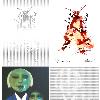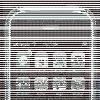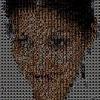

Arambilet ASCII ART. Here I stand!; Critic glance. Tags: Ascii Art View |
Tags: Ascii Art View |
Tags: Ascii Art View |
|||||||||
Tags: Ascii Art View |
Tags: Ascii Art View |
ASCII art is a graphic design technique that utilizes computers for presentation and consists of pictures pieced together from the 95 printable (from a total of 128) characters (character (computing)) defined by the ASCII Standard from 1963 and ASCII compliant character sets with proprietary extended characters (beyond the 128 characters of standard 7-bit ASCII). The term is also loosely used to refer to text based art in general (#Other text-based art). ASCII art can be created with any text editor, and is often used with free-form languages. Most examples of ASCII art require a fixed-width font (typeface#Proportion) (non-proportional fonts (typeface), like on a traditional typewriter) such as Courier (Courier (typeface)) for presentation. :ASCII ART Conqueror/Saxophonist Created in 1975 with 80 column punched cards, IBM 370-115 CPU, IBM 3203 printer. Published in February 1978 by El Caribe newspaper, section: Arts and Cybernetics". :ARTE ASCII/ASCII ART
Among the oldest known examples of ASCII art are the creations by computer-art pioneer Kenneth Knowlton from around 1966, who was working for Bell Labs at the time. "Studies in Perception I" by Ken Knowlton and Leon Harmon from 1966 shows some examples of their early ASCII art.
One of the main reasons ASCII art was born was because early printers often lacked graphics ability and thus characters were used in place of graphic marks. Also, to mark divisions between different print jobs from different users, bulk printers often used ASCII art to print large banners, making the division easier to spot so that the results could be more easily separated by a computer operator or clerk. ASCII art was also used in early e-mail when images could not be embedded.





